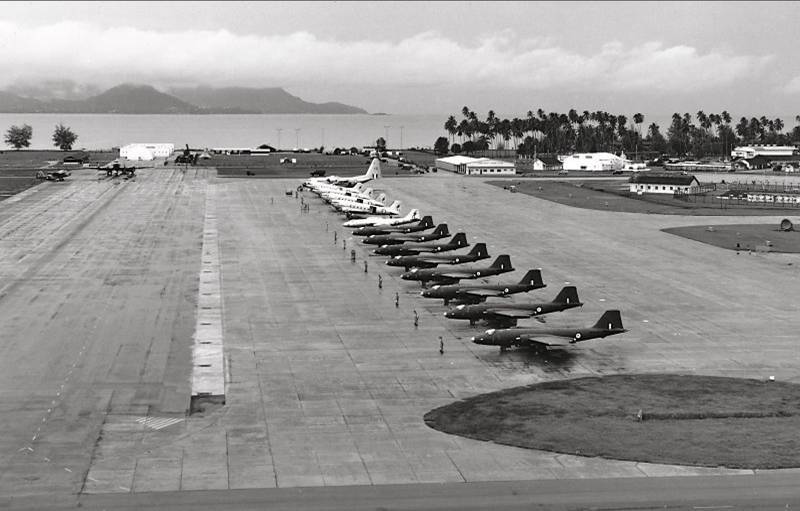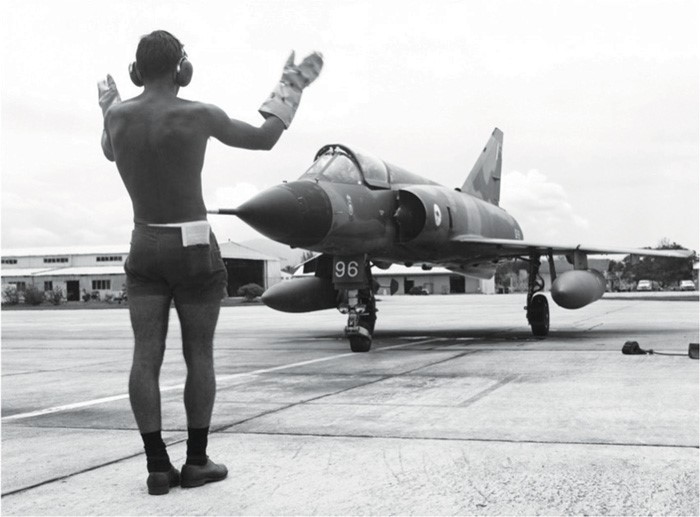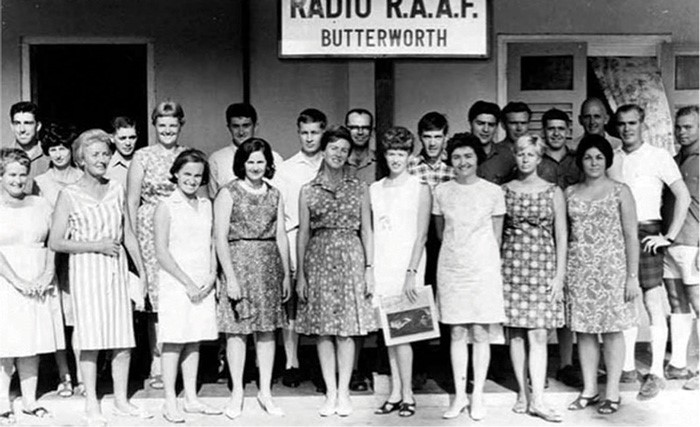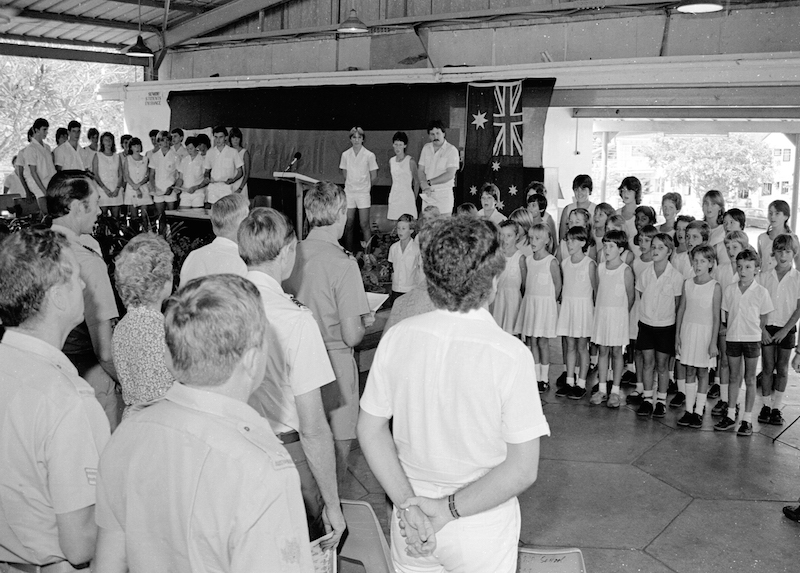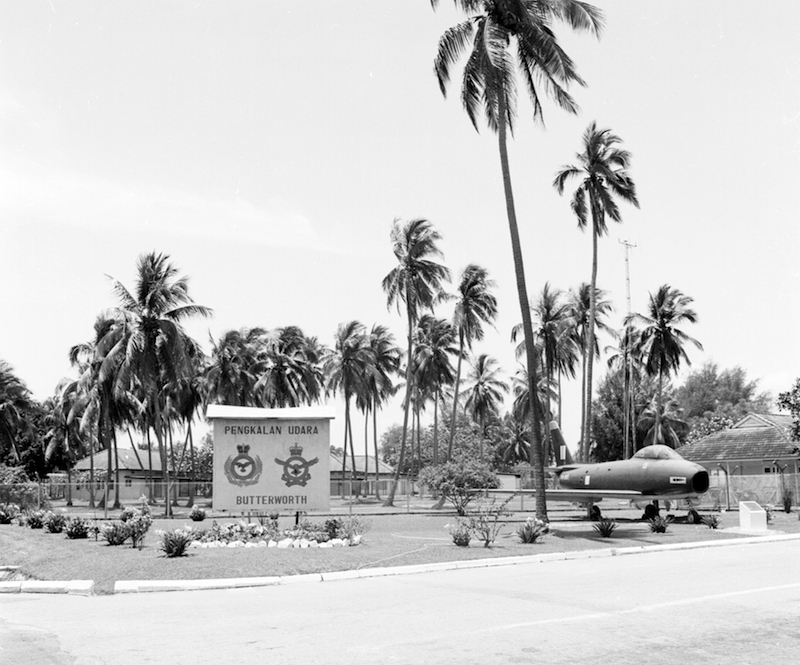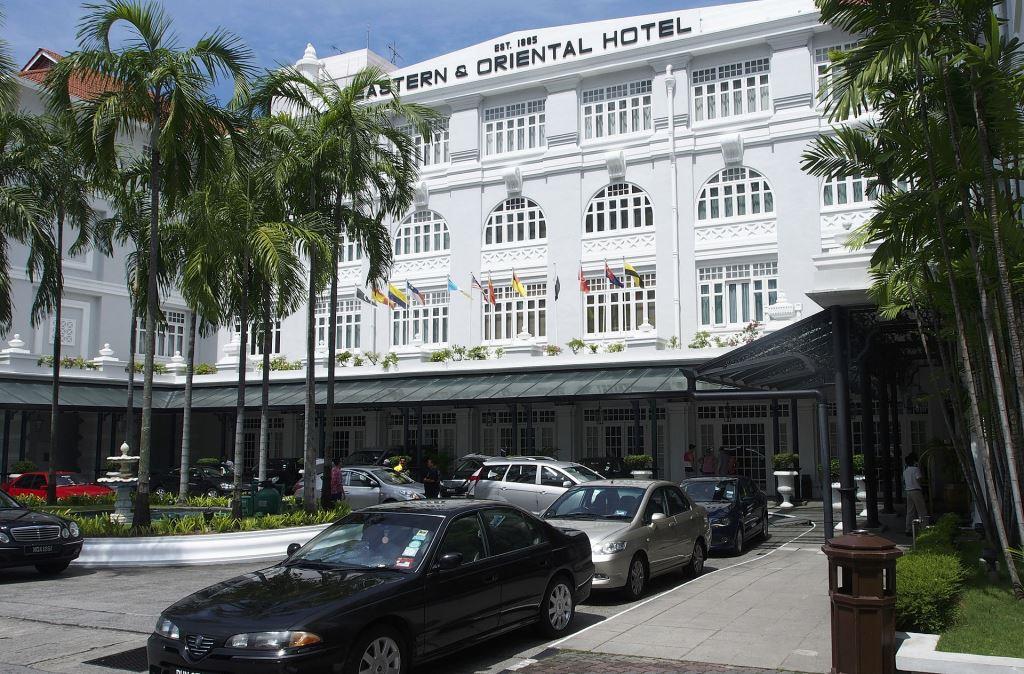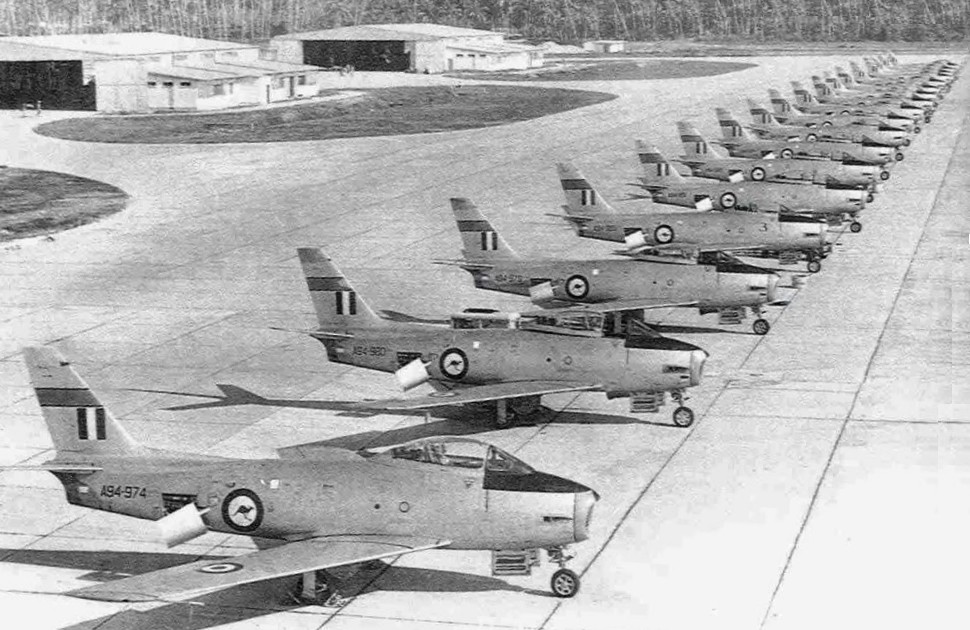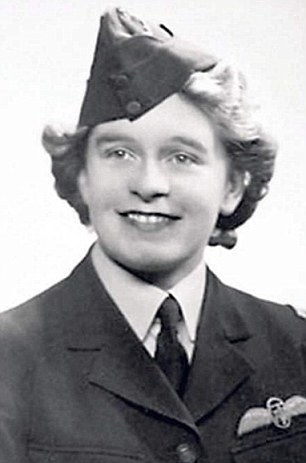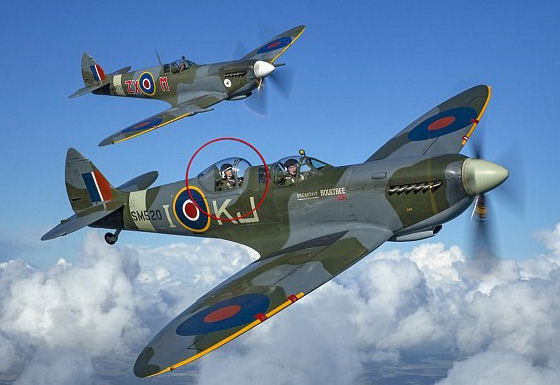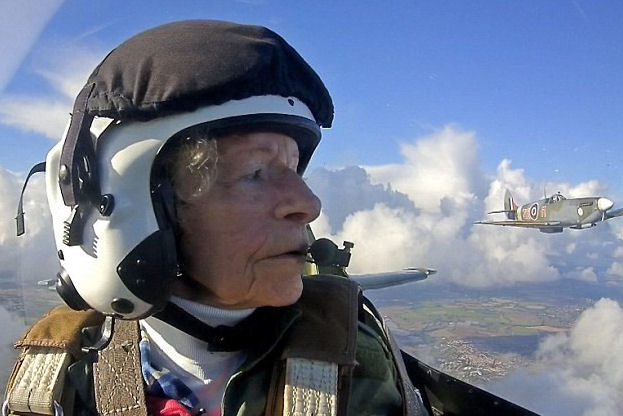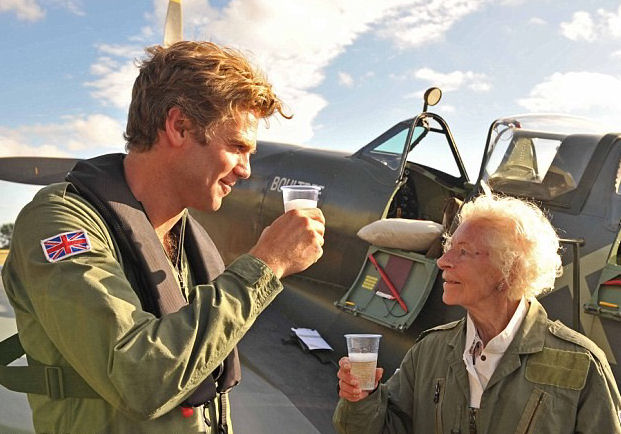|
|
||
|
||
|
Privacy Policy | Editorial Policy | Profit Policy | Join the Association | List of Members | Contact us | Index | Links |
||
|
Back Go to page: 1 2 3 4 5 6 7 8 9 10 11 12 13 14 15 16 17 18 19 20 Forward
|
||
|
|
||
|
RAAF Butterworth.
The RAAF base in Butterworth spawned a colourful community whose influences can still be felt today. It was Australia’s biggest single engagement with Asia. At one point in the 1970s there were thousands of Australians in Penang, but few here now know why they came in the first place, and what the handful of remaining Australians from the RAAF are still doing here.
|
||
|
|
||
|
Flight line in the early 1960s at RAAF Butterworth.
|
||
|
There are currently around 130 Australian service personnel stationed at the Royal Malaysian Air Force (RMAF) base in Butterworth. This base was officially opened in October 1941 as a Royal (British) Air Force (RAF) base – part of a belated attempt to defend Malaya from the Japanese during World War II.
The base then played an important role during the post-war Emergency period. RAF aircraft flew the jungle fort route from Butterworth to Kroh and Grik to help quell communist insurgents, and broadcast surrender terms to them. From the 1950s onwards, RAAF forces and forces from New Zealand became actively involved, and even as the Emergency waned, the perceived threat of a Communist resurgence elsewhere in South-East Asia prompted the British government to hand over the base at Butterworth to the RAAF on free loan in 1955.
From then onwards the work of patrolling and guarding the New Villages (designed to isolate rural residents from being influenced by the guerrillas), was largely undertaken by Australian troops. In addition, an Australian Airfield Construction Squadron was deployed that year to refurbish the facilities and prepare the base for jet operations. By May 1958 the runway, taxiways and fighter and bomber hardstands were all ready for operational use.
|
||
|
|
||
|
A typical "sun-smart" airman marshalling a Mirage at Butterworth. |
||
|
When the RAAF formally took control of the base at Butterworth on June 30, 1958 it became their first permanent major air base outside Australia. It also cemented a period of prosperity and vibrancy for Butterworth, as the RAAF personnel would come out to shop and spend at local businesses on their payday every fortnight. The troops affected the local community in many social and cultural ways too: in 1958 their Theatre Club performed an Agatha Christie play; and in 1959, a wedding was reported between one of the service personnel and Penangite Miss Chong.
The RAAF “adopted” a village called Bagan Belat, a few miles from their base, and in 1959 raised funds to repair a Malay widow’s dilapidated house. At Christmas the same year, airmen distributed gifts to 173 children of fishermen in the village; the residents of the adopted village in turn invited 20 RAAF airmen and their wives to a Hari Raya tea party in 1960.
|
||
|
|
||
|
But perhaps the broadest impact came with the launching of Radio RAAF Butterworth, which went on air for the first time on July 31, 1960. “This is Radio R double A FB!” was a well-known radio jingle to Penangites growing up in the 1960s and 1970s, who would look forward especially to Saturday nights when their song dedications might be played live on air. The announcers were all amateurs – mostly family members of the Australian servicemen – and the presentation could be amateurish, but the music repertoire was always bang up to date and exposed Penangites to international music and culture.
There were in fact two Australian communities in Penang: the one in Butterworth and another on the island in Tanjung Bungah. Australian-style houses were built for families here, and the service personnel commuted to Butterworth by ferry every day. It was in Tanjung Bungah that the first dedicated school for 600 children of RAAF personnel was opened in 1962 at Jalan Azyze at Hillside, on what had been a rubber plantation. Previously, children had been educated at leased buildings on Jalan Residensi, but with the burgeoning growth of the community, a purpose-built building had become essential.
|
||
|
|
||
|
The school was expanded several times, and in 1977 had reached a high point of 1,100 students and 50 teachers. It was unique – the only school for Australian children outside Australia, and the only international RAAF school in existence. And because RAAF personnel moved on every two to three years, the school suffered a regular 1005 turnover of its student body. The school would also enter pupils into local sporting competitions, and occasionally this resulted in young Australians winning national competitions. See HERE.
Also in 1962, the RAAF Club was founded at 10, Jalan Tanjong Tokong, on premises that had previously served the British army. It provided 72 rooms available for accommodation for newly arrived families awaiting housing, and recreational, sporting and general meeting facilities. It housed a health centre, staffed 24 hours a day, seven days a week; the chaplain’s office; a post office; shops including a milk bar, hairdresser, barber, dressmaker, gift shop and travel agent; a pay telephone; and a library. The main auditorium was used almost daily for events such as films, conferences, dances, dinners, parties and theatre group productions. Rooms were available for hobby groups such as macramé, handicrafts, weight watchers and keep-fit classes. Of course there were also bars, a restaurant and a wide range of facilities for sports such as badminton, tennis, basketball, boxing, volleyball, table tennis, darts and carpet bowls.
|
||
|
|
||
|
Meanwhile at the base in Butterworth, people would congregate at the swimming pool, squash courts and the golf club. Butterworth also housed the main RAAF hospital, which local residents also had access to, and which at one point was delivering as many as 150 babies per year.
Unsurprisingly, personnel who came for their two to three-year postings loved their time in Penang, and just about everyone wanted to be posted here. It was a job of course, but then when you went home at the end of the day it was like being on holiday. People didn’t want to leave, and in 1965 an unusually high 805 of servicemen at the base were married, because so many had got married just so they could take their fiancées or girlfriends with them to Penang.
Their standard of living was remarkably luxurious compared to back home. As one serviceman remarked of his stay in the 1960s: “I was 25 and a Flying Officer and we were put up in the Eastern and Oriental Hotel waiting for a married quarter, and then we were given a married quarter on the island, a huge two-storey place with about five or six bedrooms. Then of course we then went out and hired a cook and an amah.” Whether it was the exotic foreign location, the climate, the people, the different cultures or the shared sense of experience, everyone posted in Penang went home with great memories.
|
||
|
|
||
|
In the 1960s the Butterworth base provided aircraft and maintenance personnel in support of deployments in Thailand, along with medical and transport support facilities during the Vietnam War. The RAAF No. 2 Squadron, based at Butterworth since 1958, joined the other Australian forces on active duty in Vietnam from 1967. But the base became especially crucial between 1963 and 1966 for both defensive and offensive operations during the Indonesia-Malaysia Confrontation that stemmed from Indonesia’s opposition to the creation of Malaysia.
After the end of the Confrontation, the British government announced plans for the withdrawal of its forces from the east of Suez. In line with an earlier Anglo-Malayan agreement, ownership of the Butterworth base was transferred to the Malaysian government in 1970, but the RAAF was immediately given joint control over the base as part of the Five Power Defence Arrangements (FPDA), in which Britain, Australia, New Zealand, Singapore and Malaysia agreed that in the event of any form of external armed attack or threat against Malaysia or Singapore they would consult each other about the response.
|
||
|
|
||
|
In 1971 the Headquarters of the Integrated Air Defence System (IADS) was formed at Butterworth with Australia providing its Commander. IADS assumed operational responsibility for the air defence of Malaysia and Singapore. It was intended to be a transitional arrangement, but was re-designated in 2001 as Headquarters Integrated "Area" Defence System. It now has personnel from all three branches of the armed services, and still co-ordinates the annual five-power naval and air exercises. The FPDA is the longest standing multilateral security arrangement in South-East Asia today.
The base reached its peak strength during the late 1970s, with 1,200 personnel, 3,500 dependents and 1,000 Malay, Indian and Chinese employees, but the Australian contingent was reduced considerably after June 30, 1988, when the airfield was handed over to the RMAF and renamed RMAF Station Butterworth. The school was closed, with remaining pupils sent to Uplands and St Christopher’s international schools, and the buildings at Hillside became the RMAF training facility and administration centre. The RAAF Club was also closed, and a new, much smaller RAAF Centre was established to cater for the reduced number of families. The former RAAF Club building was knocked down and today’s Precinct 10 shopping mall was built in its place.
With the number of Australians at a fraction of its previous level, there are few signs that Penang once welcomed those thousands of RAAF airmen and their families, with the exception of one of their favourite old haunts, the Hong Kong Bar on Lebuh Chulia. This bar proudly exhibits its past, with framed pictures of RAAF personnel and their families and other RAAF plaques and mementos on the walls.
|
||
|
|
||
|
The RAAF Office of Air Force History has produced an interesting short story on “Air Base Butterworth” – you can read it HERE.
|
||
|
“Do not touch” must be one of the scariest things to read in Braille.
|
||
|
Mary Ellis – a wonder-woman.
Mary Ellis, (right) a 100-year-old woman who flew spitfires during the Second World War recently celebrated her centenary by getting behind the controls again
Tearing through the skies above the South Coast, two Spitfires evoke powerful memories of Britain's wartime resilience. But this stirring image holds a further poignancy – for in the cockpit of the lead aircraft sits Mary Ellis, celebrating her 100th birthday by recreating her time as one of the 'Ata-girls', the select gang of female pilots who flew Britain's fighters during the war. And over her shoulder is one of the actual Spitfires she flew during her 1,000 flights as a First Officer with the Air Transport Auxiliary.
Mary was handed the controls of the twin-seater as it swooped over West Sussex. After about 15 minutes, she turned for home and told her co-pilot Matt Jones: 'Goodwood on the nose, you have control…'. Then she settled back to enjoy the ride back to base.
Earlier, Mary watched in delight as Spitfire MV154 took its place beside her in an extraordinary airborne tribute. It was a plane she had delivered to RAF Brize Norton from Southampton on September 15, 1944 and it hides a sentimental secret. For at the end of the 25-minute wartime flight, she signed the cockpit, scrawling her maiden name Wilkins and the initials ATA.
|
||
|
|
||
|
Mary Ellis (circled)
She hoped her tag might be spotted by a handsome pilot and lead to a wartime romance, although the impulsive act, a career one-off, didn't bag her a boyfriend. Mary, originally from Oxfordshire, had her first flying lesson in 1938, and flew for pleasure until 1941 when she heard a BBC radio appeal for women pilots to join the auxiliary service and so release male pilots for combat duty.
Speaking at a surprise birthday party on Thursday, Mary said: 'The war was a challenge and one had to do something about it. I went on and on until I flew everything. I loved the Spitfire, it's my favourite aircraft, it's everyone's favourite, it's the symbol of freedom.'
For four years she ferried warplanes from factories to frontline squadrons. The 166 women of the ATA – about one in eight of the total – have been dubbed 'The Female Few', echoing Winston Churchill's description of the RAF airmen who fought in the Battle of Britain.
|
||
|
|
||
|
Mary looked back over her left shoulder and glanced at the aircraft she once flew
|
||
|
Mary was usually found at the joystick of a Spitfire or a Hurricane but ultimately flew more than 50 types of aircraft, logging 1,100 hours of flight, much to the astonishment of some colleagues. As she sat on the airfield ready to deliver her first Spitfire, the mechanic standing on the wing asked how many of them she'd flown. When she said it was her first, he was so startled he fell right off. The largest aircraft she flew solo was the Wellington bomber. After landing at an East Anglian airfield, Mary was greeted by the ground crew who asked where the pilot was. 'I'm the pilot,' she said. They insisted on searching the aircraft before they believed her.
It was dangerous work. Mary was sometimes ordered to move combat-damaged planes that were not officially fit to fly, but had to be taken for repairs. She crash-landed twice and was shot at once.
|
||
|
|
||
|
Mary Ellis toasted a glass of champagne with co-pilot Matt Jones, managing director of Boultbee Flight Academy.
Fourteen of her fellow ATA female flyers lost their lives, including aviation pioneer Amy Johnson. Mary – who to this day needs no spectacles, nor a walking stick – was one of the last six women serving in the ATA when it disbanded after the war. She remained a private pilot and then became managing director of Sandown Airport on the Isle of Wight. She married Don Ellis, a fellow pilot, in 1961, but was widowed in 2009. Matt Jones, who flies Spitfires for Goodwood-based Boultbee Flight Academy, reunited Mary with MV154 after first meeting her in 2015. He conspired with the plane's current owner, pilot Maxi Gainza, to bring it to the UK from its base in Bremgarten, Germany.
He said: 'I gave Mary control of our Spitfire. I wasn't sure where we were but Mary was very clear. She pointed us towards Thorney Island, up through the Witterings, flew on to Selsey Bill and then Bognor Regis, never losing a foot of altitude.
'She showed me precisely how she was able to deliver all those aircraft with just a map, a compass and a stopwatch. I was utterly humbled by a superior aviator who also happens to be 60 years my senior!'
Click the pic below to see a wonderful video on these marvellous ladies.
|
||
|
My wife just opened my car door for me, Would have been a nice gesture had we not been doing 70 mph.
|
||
|
|
||
|
|
||
|
Back Go to page: 1 2 3 4 5 6 7 8 9 10 11 12 13 14 15 16 17 18 19 20 Forward |
||
|
|

